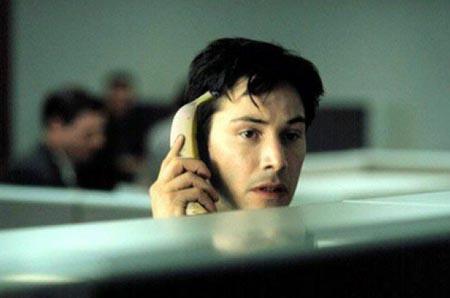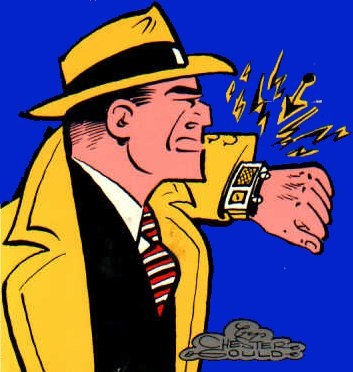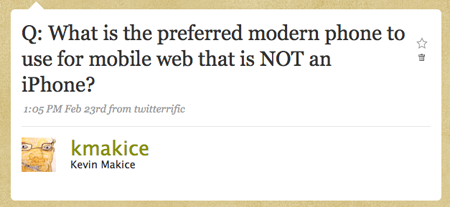In addition to family expansion and academic projects, I have been tasked this season with investigating designing for the mobile web. Hanapin Marketing is interested in moving into that domain, which currently is a wide-ranging wilderness of devices, protocols, and use. To help get a handle on this area of design, I’m going to journal the process of moving from n00b to l33t as a consumer of mobile web.

I am a cell phone n00b
Not Smart at the Start
I never liked the idea of talking on cell phones and only reluctantly agreed to get one to appease my wife’s desire to be able to reach me directly. Mostly, my phone sat in my pocket—often dialing nonsensical numbers as I walked about, until someone taught me how to lock the keypad—and waited until Amy called. I’m a good case study for this kind of journey, being an early adopter of most kinds of technology as an adult, but a reluctant user of cell phones—which means, I have the predisposition to dive into what is for me a new technology.
My hate-hate relationship with cell phones began with the absence of a dial tone, that important cue that on a land line phone tells me that a connection has not yet been established. It was always a bit disconcerting to pick up my simple Nokia 3120 and not hear that familiar buzz. I also rejected texting from the start because it was too awkward to use a numeric keypad to form letters (which I tended to type with my index finger, not my thumbs). In both cases, the barrier to use was found in my attachment to existing routines and experiences.
One unanticipated value that Nokia brought me was a clock. I long ago stopped wearing wristwatches, because they kept stopping on me. Even more than the phone calls, I used my Nokia as a timepiece. It gave me something to look at while waiting for the bus to arrive. In essence, my cell has long served as a watch I can use to communicate, like Dick Tracy’s two-way radio of yore.

Dick Tracy and his two-way radio watch
Evolution of Use
After losing my Nokia bar phone at a local park, I spent some time with an old Motorola phone that had terrible reception. That was eventually replaced with a new Sony Ericsson Z310a, my current phone and my first with a camera.
The transition was somewhat awkward when I realized how much contact information I had kept on my lost phone. Some of the phone numbers of friends and colleagues had only be stored in the cell phone address book and were never replaced (most of my use remains talking to Amy). However, that was the extent of my customization. I didn’t have a custom ring tone, but I did miss the simple chirp-chirp I used with the Nokia. I never wanted my phone to sing as much as signal.
I did try the camera soon after receiving the new phone. The pictures were very low resolution with no real use outside of the device. I managed to get a snapshot of my youngest son to use as a background image, but it hasn’t been used since.
One major behavior change for me came about not because of the phone, but as a byproduct of using Twitter extensively. I configured my phone to receive all direct messages (not the tweets themselves) and found myself texting messages to 40404 while waiting for a bus, riding in the car, or at other locations where my laptop was not available. This was the first appealing consequence of mobility. Much like my switch from desktop to wireless laptop a few years earlier, mobility makes me very aware of how tethered I am in my regular routines.
Looking to Get Smart
None of my prior phones—which also includes a big bulky CellularOne box from the mid ’90s—were considered “smart,” although that line is a bit blurry. A smartphone typically includes the non-phone features that might be found on a typical PDA, such as email clients and note editors. Under that definition, my Sony Ericsson is a smart phone, as it does have email capability (I don’t use it) and MEdia Net, a mobile web infrastructure by AT&T. However, About.com lists the following as additional criteria that a true smartphone will have:
- Operating System—The BlackBerry has BlackBerry OS; the iPhone has the iPhone OS; the Android has the Android OS; and, other devices run on systems like Palm OS or Windows Mobile.
- Software—Smartphones go beyond basic address books and allow you to edit Word documents, edit photos, view maps for driving directions, play music, or manage finances.
- Messaging—Smartphones go beyond the sending and receiving of text messages by providing clients to manage multiple e-mail and chat clients.
- Web Access—Cell phone carriers have data plans that let you access web content, or you can do it pay-as-you-go (at a penny per KB, that can get quite costly). Transfer speed is an issue separate from access; those without 3G data networks will suffer slow navigation.
- QWERTY Keyboard—This is definitely one criterion that keeps my phone dumb. My clamshell device has a standard numeric keypad, not the standard keyboarding layout.
My first experiences with a smartphone were limited to watching friends and colleagues play with new iPhones. The sexy design, touch interface, and explosion of fun and useful applications caught my eye, but what turned me green was the constant access to Twitter, Wikipedia, Google Maps, and other sources of information and connection. My phone configuration allowed me to send out, but not receive.

Crowdsourcing led me to the Android G1
Creating a Monster
When Hanapin offered to get a smart phone for my use, Pat East and I ruled out the iPhone and Blackberry because we already knew people with those devices. I crowdsourced the question and wound up with a strong recommendation from my social network to get an Android G1. After confirming that I could use it without a service plan, we wound up ordering the works from T-Mobile.
My charge now is to figure out how to use it, both from a technical perspective and from an experiential one. I fully expect to have fun exploring applications, probably after some fear and headaches about activating it. I am certain my Twitter behavior will change, as will my reliance on the laptop (which I may power down with greater frequency). Mostly, I want to explore the obstacles this system puts in place that prevent widespread consumption of the mobile web.
3 replies on “Becoming Smarter”
Great post!
[…] new Android G1 is a bit of a culture shock, but it is just old enough to have drifted past shiny and into normal. I am much better at the […]
[…] journey into the community of practicing smartphone aficionados began in earnest today when I unboxed my new Android G1, courtesy Hanapin Marketing. Before that moment, I had held one […]